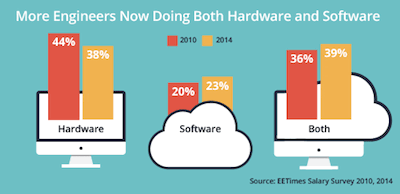From getting familiar with open source software to developing apps, industry professionals are urging embedded engineers to get out of their comfort zone and acquire new skills to stay relevant.
Back in the early days of embedded in the 1980s, the guy (and it was mostly guys then) who designed the mixed signal circuits, the guy who connected the microcontroller, the guy who wrote a bunch of low-level assembly code, and the guy who got the prototype out the door — well, it was all the same guy.
One engineer pretty much did it all.

Then, as embedded systems became bigger and more complex — millions of lines of code now ship with devices — embedded skill sets became partitioned by discipline: hardware developer, firmware developer, software developer.
In many big companies that is still the case. But the pendulum appears to be swinging back, as more and more companies are consolidating engineering roles, looking for developers who are fluent in both hardware and software, and trying to accomplish more with less. Certainly a bigger percent of engineers say they work on both hardware and software, as compared to the group that only does one or the other.
Given that it’s not possible to keep up with everything embedded, how do you make sure that the new skills you acquire are the most relevant?
EE Times turned to nine embedded professionals and a recruiter and asked them to tell us what they think are the most important things engineers should learn now.
Though opinions differed on the specific skills that are most important, they all agreed on one thing all engineers should do: Never stop learning.
Go to next page.